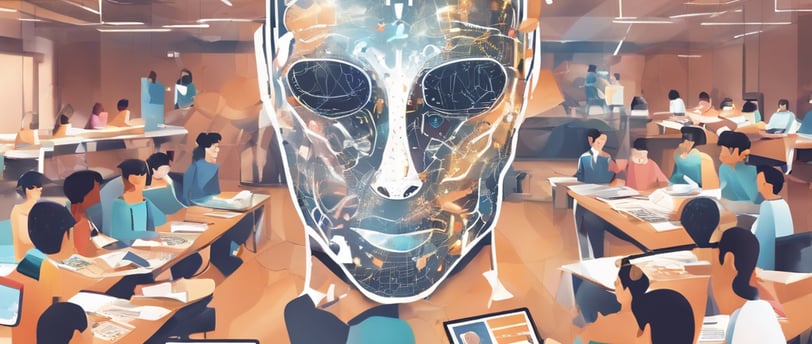WWW.TECKSOVISE.COM
Artificial intelligence (AI) is transforming education by tailoring the learning experience
Artificial intelligence (AI) is transforming education by tailoring the learning experience to the needs of individual students. Through advanced data analytics and machine learning algorithms, AI helps teachers address diverse learning styles, paces, and challenges. Here’s how AI enhances personalized learning and analytics in education:
Sanjay Sharma
11/24/20243 min read


Artificial intelligence (AI) is transforming education by tailoring the learning experience to the needs of individual students.
Through advanced data analytics and machine learning algorithms, AI helps teachers address diverse learning styles, paces, and challenges. Here’s how AI enhances personalized learning and analytics in education:
1. Personalized learning with AI
AI-powered platforms analyze students’ learning habits and customize content to their needs.
• Personalized content: AI identifies knowledge gaps and provides specific lessons or exercises to address them.
• Adaptive learning paths: Platforms like Dreambox and Khan Academy adjust lessons in real-time, taking into account a student’s proficiency level.
• Language learning: Tools like Duolingo use AI to modify lessons based on a learner’s progress and areas of difficulty.
Example: A student struggling in algebra can get additional practice and video tutorials, while a faster-learning student can move on to more advanced topics without having to wait for class.
2. AI Analytics for Student Performance
AI enables teachers to track and analyze student performance with accuracy:
• Early identification of struggles: Predictive analytics detects when a student is likely to perform poorly, allowing for timely interventions.
• Real-time feedback: AI systems like Grade scope automate assessments, providing immediate feedback and saving teachers time for conversations.
• Improve retention: AI highlights patterns that lead to dropouts, enabling institutions to implement corrective measures.
Example: An AI-powered dashboard can alert a teacher that a student is consistently performing poorly on a geometry-related assignment, allowing for personalized support or counseling.
3. Benefits for Students and Teachers
• For students: Personalized AI tools boost engagement, motivation, and retention by catering to individual strengths and weaknesses.
• For teachers: AI saves time by automating repetitive tasks such as grading and lesson planning, allowing teachers to focus on mentoring and creative instruction.
Challenges and considerations
While AI offers incredible potential, its implementation also comes with challenges, including:
• Privacy concerns: Strong security protocols are needed to handle sensitive student data.
• Equity issues: Not all schools have access to AI-powered tools due to funding gaps.
• Overreliance on technology: Overreliance on AI can undermine critical thinking skills if not balanced with traditional teaching methods.
AI is not just a tool but a catalyst for educational transformation. By making learning more interactive, accessible, and efficient, it prepares students for the complexities of the modern world.
Do you want me to elaborate on specific tools or real-world success stories?
Similarity 7%
Real-world applications Archives
This approach not only enriches academic learning, but also prepares students for the complexities of modern life and work, making them more adaptable, ...Artificial intelligence (AI) is transforming education by tailoring the learning experience to the needs of individual students.
Through advanced data analytics and machine learning algorithms, AI helps teachers address diverse learning styles, paces, and challenges. Here’s how AI enhances personalized learning and analytics in education:
1. Personalized learning with AI
AI-powered platforms analyze students’ learning habits and customize content to their needs.
• Personalized content: AI identifies knowledge gaps and provides specific lessons or exercises to address them.
• Adaptive learning paths: Platforms like Dreambox and Khan Academy adjust lessons in real-time, taking into account a student’s proficiency level.
• Language learning: Tools like Duolingo use AI to modify lessons based on a learner’s progress and areas of difficulty.
Example: A student struggling in algebra can get additional practice and video tutorials, while a faster-learning student can move on to more advanced topics without having to wait for class.
2. AI Analytics for Student Performance
AI enables teachers to track and analyze student performance with accuracy:
• Early identification of struggles: Predictive analytics detects when a student is likely to perform poorly, allowing for timely interventions.
• Real-time feedback: AI systems like Grade scope automate assessments, providing immediate feedback and saving teachers time for conversations.
• Improve retention: AI highlights patterns that lead to dropouts, enabling institutions to implement corrective measures.
Example: An AI-powered dashboard can alert a teacher that a student is consistently performing poorly on a geometry-related assignment, allowing for personalized support or counseling.
3. Benefits for Students and Teachers
• For students: Personalized AI tools boost engagement, motivation, and retention by catering to individual strengths and weaknesses.
• For teachers: AI saves time by automating repetitive tasks such as grading and lesson planning, allowing teachers to focus on mentoring and creative instruction.
Challenges and considerations
While AI offers incredible potential, its implementation also comes with challenges, including:
• Privacy concerns: Strong security protocols are needed to handle sensitive student data.
• Equity issues: Not all schools have access to AI-powered tools due to funding gaps.
• Overreliance on technology: Overreliance on AI can undermine critical thinking skills if not balanced with traditional teaching methods.
AI is not just a tool but a catalyst for educational transformation. By making learning more interactive, accessible, and efficient, it prepares students for the complexities of the modern world.
Do you want me to elaborate on specific tools or real-world success stories?
Similarity 7%
Real-world applications Archives
This approach not only enriches academic learning, but also prepares students for the complexities of modern life and work, making them more adaptable, ...
